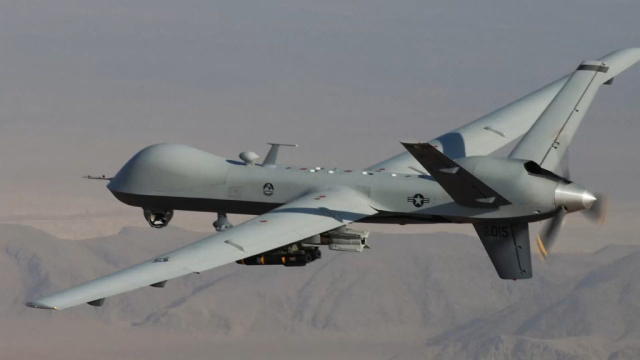Air Force to Offer Larger Retention Bonuses, Much Like the Maximum $25,000 Stipend, and Double the Monthly Incentive Pay for Drone Operators — from $600 to $1,500 — to Persuade Them to Stay in the Air Force
Air Force to tap Guard, Reserve to fill drone pilot shortage

January 16, 2015
AP - The Air Force is taking several steps to fill a significant shortfall in drone pilots, laying out plans to increase incentive pay, bring more National Guard and Reserve pilots onto active duty, and seek volunteers to fill needed slots, Air Force Secretary Deborah Lee James said Thursday.
Calling them interim measures, James told reporters they may seek larger retention bonuses for drone pilots, much like the maximum $25,000 stipend that manned aircraft pilots can receive. While the Air Force has long struggled with a shortage of drone operators, the demands of ongoing operations around the world, including persistent airstrikes in Iraq and Syria, have exacerbated the problem.
The Air Force chief of staff, Gen. Mark Welsh, said plans to reduce the number of combat air patrols by drones are instead "on an upward trend" because of the missions in Iraq and Syria."This is a force that is under significant stress from what is an unrelenting pace of operations," James said.
"We have just got to get ahead of this," said Welsh, adding that the Air Force can train only 180 drone pilots a year, despite an annual need for 300.
James said she will double the monthly incentive pay for some drone operators — from $600 to $1,500 — to persuade them to stay in the Air Force. The increased bonus pay would be targeted to those who have finished their initial six-year service commitment. All drone pilots now get the $600 monthly stipend, but James said current policies do not allow her to give any a retention bonus of up to $25,000 to encourage them to stay in the service.
The shortage of drone pilots dates back to at least 2008, when the service was forcing fighter pilots to transfer to the unmanned aircraft to meet escalating demands for wartime surveillance and strike operations. Two years ago, the service was struggling to fill a shortfall of 300 drone pilots to meet the continuing demand for surveillance and airstrike operations in Afghanistan, while other regions, such as Asia, also sought more patrols.
Drone pilots work six days in a row, for an average of 13 to 14 hours a day. They log 900-1,100 flight hours a year, compared with pilots who fly manned aircraft and put in between 200-300 hours per year, James said.
"We are getting too small to succeed," said Welsh.
US Air Force moves to stem shortage of drone pilots
January 16, 2016AFP - Facing a shortage of drone pilots, the US Air Force said Thursday it will increase pay for those who operate the robotic planes and draw on airmen from the reserves to fill the gap.
"This is a force that is under significant stress from what is an unrelenting pace of operations," James said.
The military had expected the need for drone flights to decline slightly with the withdrawal of most troops from Afghanistan. But the US-led air campaign against IS jihadists launched in August has fueled yet more requests for the more than 360 unmanned aircraft in the Air Force fleet, officials said.
An internal memo leaked to The Daily Beast last week quoted a top commander warning that drone operations had reached a crisis point due to the manpower shortage, and that the Air Force would not be able to meet a Pentagon demand for 65 drone combat air patrols this year."We thought we were drawing down and had a plan in place to man this enterprise that would, if we had actually drawn down, we'd be fine right now," said General Mark Welsh, the Air Force chief of staff.
With a large number of the drone pilots approaching the end of their commitment to the military, commanders are anxious to avoid a brain drain and are looking for ways to persuade them to stay in uniform.
"We've met the operational demand signal, but we're doing it by putting people in a position where they're now having a debate whether they want to continue doing this," Welsh said.
The Air Force secretary unveiled what she called "first steps" designed to relieve the pressure on the pilots. But additional measures are being drawn up, possibly including initiatives to be funded in the Pentagon's budget request to Congress next month.
Some troops who have been trained as drone pilots but have since moved on to other assignments will be asked to return to the drone mission."We will maximize the use of the National Guard and reserve and indeed, we will be redirecting some resources in order to provide the money to bring additional personnel on active duty," she said.
"We're also looking at pay," James said.




No comments:
Post a Comment